November 2021 Regulatory Update
The Food and Drug Administration (FDA intends to withdraw the temporary guidances for alcohol-based hand sanitizers, effective 31 December 2021.
After that date, if manufacturers would like to continue producing hand sanitizer, they will need to comply with the tentative final monograph for over-the-counter topical antiseptics and the FDA’s relevant Good Manufacturing Practice (GMP) requirements.
On 12 October 2021, the FDA announced the intention to withdraw the three guidances for alcohol-based hand sanitizers, effective 31 December 2021. Those guidances were issued in March 2020 as temporary policies for manufacturers that were not drug manufacturers to provide regulatory flexibility to address the increase in the demand of alcohol-based hand sanitizers during the COVID-19 pandemic. The FDA is withdrawing the three guidances as current data shows a stable supply for alcohol-based hand sanitizer on the market.
After 31 December 2021, companies must stop producing alcohol-based hand sanitizers under the temporary policies. Any remaining hand sanitizer produced under the temporary guidances can no longer be sold or distributed by manufacturers after 31 March 2022.
If these manufacturers would like to continue producing hand sanitizer, they will need to comply with the tentative final monograph for over-the-counter topical antiseptics and FDA’s relevant Good Manufacturers Practice (GMP) requirements. Otherwise, they may deregister by referring to the directions on the Electronic Drug Registration and Listing System instructions page.
The U.S. Consumer Product Safety Commission (CPSC) staff is participating in voluntary standard activities related to batteries in consumer products, including UL 4200A - Standard for Safety for Products that Incorporate Button or Coin Cell Batteries of Lithium Technologies.
View Story Read MoreSpecific to UL 4200A, this standard is designed to reduce the risk of children removing button and coin cell batteries from products and ingesting batteries. These lithium batteries can cause serious harm to children.
There are more and more deaths and serious injuries associated with button cell batteries. These incidents generally involve children under the age of four. Serious injury can occur when the battery remains in the digestive tract or other parts of the body.
In order to address these issues, UL has formulated standard UL 4200A to ensure the safety of products containing button batteries during their use.
UL 4200A requires that products containing removable batteries use specified methods to ensure reliable placement of batteries. The standard details performance criteria, including abuse, and aims to assess the possibility of accidental release of batteries from products.
UL 4200A also describes how the product should be marked, including warnings about hazards, and keeping batteries away from children. The standard contains specific language describing possible injuries caused by swallowing batteries and the need for immediate medical treatment.
UL 4200A scope:
1.1 These requirements cover household type products that incorporate or may use button or coin cell batteries of lithium technologies.
1.2 These requirements do not cover products that exclusively use forms of batteries other than lithium button or coin cells.
1.3 These requirements apply to consumer products containing lithium button or coin cells. They do not apply to products that by virtue of their dedicated purpose and instructions are not intended to be used in locations where they may be accessed by children, such as products for dedicated professional use or commercial use in locations where children are not normally or typically present.
1.4 These requirements are intended to supplement other safety requirements for products that incorporate button or coin cell batteries and are not intended to supersede specific requirements that are incorporated into other safety standards to mitigate physiological hazards from button or coin cells.
Website: https://www.cpsc.gov/Regulations-Laws--Standards/Voluntary-Standards/Topics/Batteries
Contact: Vincent Wong (Technical Consultant for E&E)
Phone: (852) 3185 8000
Email: regulatoryupdates@qima.com
In July 2021, the CPSC was notified by ASTM that ASTM F1004-19 Standard Consumer Safety Specification for Expansion Gates and Expandable Enclosures was updated to ASTM F1004-21. The CPSC has issued final rule to incorporate by reference the 2021 version of the voluntary standard.
This rule will be effective on 2 January 2022.
ASTM made minor/editorial changes and substantive revisions throughout ASTM F1004-21 including the following examples:
Minor/editorial changes:
- Hyphenated multiple terms used as adjectives, such as “single-action”, “pressure-mounted”, “partially-bounded”, and “hold-open”, throughout;
- Corrected the spelling of “guage” to “gauge” in section 3.1.16;
- Added conversions to Celsius in section 4.4;
- Changed the capitalization of some terms, such as “Small Torso Probe” to “small torso probe”;
Substantive revisions:
- Added a requirement of a visual side-pressure indicator for pressure-mounted gates that do not incorporate wall-cups.
- Added a new section 8.5.7 to the wall-cup warning requirement.
Contact: Vivian Chan (Technical Consultant)
Phone: (852) 3185 8052
Email: regulatoryupdates@qima.com
The California State government passed Assembly Bill No. 1200 in October 2021 to restrict perfluoroalkyl and polyfluoroalkyl substances (PFAS) in plant-based food packaging and required the disclosure of a designated list of chemicals in cookware.
View Story Read MoreEffective 1 January 2023, any food packaging that contains regulated perfluoroalkyl and polyfluoroalkyl substances or PFAS (≥ 100 ppm as measured in total organic fluorine) is not allowed to be sold or distributed in the State of California.
“Food packaging” means a nondurable package, packaging component, or food service ware that is comprised of paper, paperboard, or other materials originally derived from plant fibres.
Effective 1 January 2023, handles of cookware or cookware food contact surfaces that contain intentionally added chemicals present on the designated list shall post the chemical information on the internet website.
Effective 1 January 2024, handles of cookware or cookware food contact surfaces that contain intentionally added chemicals present on the designated list shall list the chemicals on the product label.
“Designated list” means the list of chemicals identified as candidate chemicals that exhibit a hazard trait or an environmental or toxicological endpoint that meets the criteria specified in regulations adopted by the Department of Toxic Substances and is published on the Department of Toxic Substances Control’s internet website.
Contact: Andy Choi (Senior Manager)
Phone: (852) 3185 8045
Email: regulatoryupdates@qima.com
The California State government passed Assembly Bill No. 652 in October 2021 to restrict perfluoroalkyl and polyfluoroalkyl substances (PFAS) in products designed for use by infants and children under 12 years of age (Juvenile products). The effective date is 1 July 2023.
View Story Read MoreEffective 1 July 2023, juvenile products that contain regulated PFAS chemicals (≥ 100 ppm as measured in total organic fluorine) are not allowed to be sold or distributed in the State of California.
“Juvenile product” means a product designed for use by infants and children under 12 years of age, including, but not limited to, a baby or toddler foam pillow, bassinet, bedside sleeper, booster seat, changing pad, child restraint system for use in motor vehicles and aircraft, co-sleeper, crib mattress, floor playmat, highchair, highchair pad, infant bouncer, infant carrier, infant seat, infant sleep positioner, infant swing, infant travel bed, infant walker, nap cot, nursing pad, nursing pillow, playmat, playpen, play yard, polyurethane foam mat, pad, or pillow, portable foam nap mat, portable infant sleeper, portable hook-on chair, soft-sided portable crib, stroller, and toddler mattress.
The following are excluded
- certain children’s electronic products or any associated peripheral,
- medical devices,
- inaccessible components of a juvenile product,
- adult mattresses.
Contact: Andy Choi (Senior Manager)
Phone: (852) 3185 8045
Email: regulatoryupdates@qima.com
In the US, when hazards are identified in consumer products, they will be recalled and published in the Consumer Product Safety Commission (CPSC) Recent Recalls on the CPSC website, which is updated daily. The US recalls from 01 October 2021 to 31 October 2021 are summarized below:
View Story Read More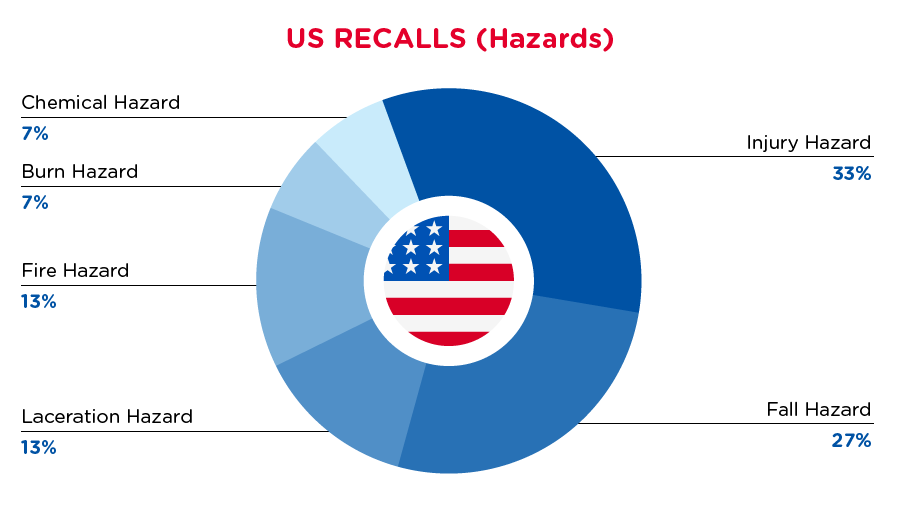
| Hazards | Frequency |
| Fall Hazard | 4 |
| Injury Hazard | 5 |
| Fire Hazard | 2 |
| Laceration Hazard | 2 |
| Burn Hazard | 1 |
| Chemical Hazard | 1 |
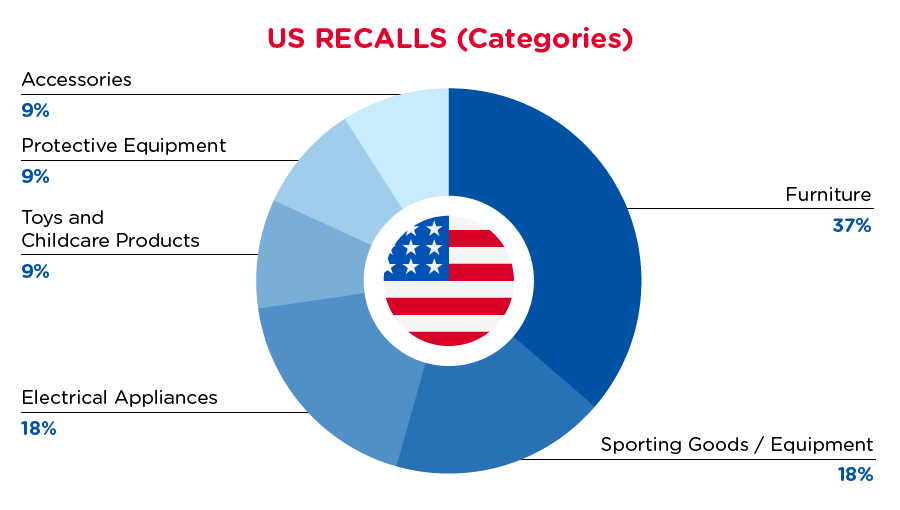
| Product Categories | Frequency |
| Furniture | 4 |
| Sporting Goods / Equipment | 2 |
| Toys and Childcare Products | 1 |
| Electrical Appliances | 2 |
| Accessories | 1 |
| Protective Equipment | 1 |
For a complete list click here
In Canada, when hazards are identified in consumer products, they will be recalled and published in the Recalls and Safety Alerts Database on the Health Canada website, which is updated daily. The Canada recalls from 01 October 2021 to 31 October 2021 are summarized below:
View Story Read More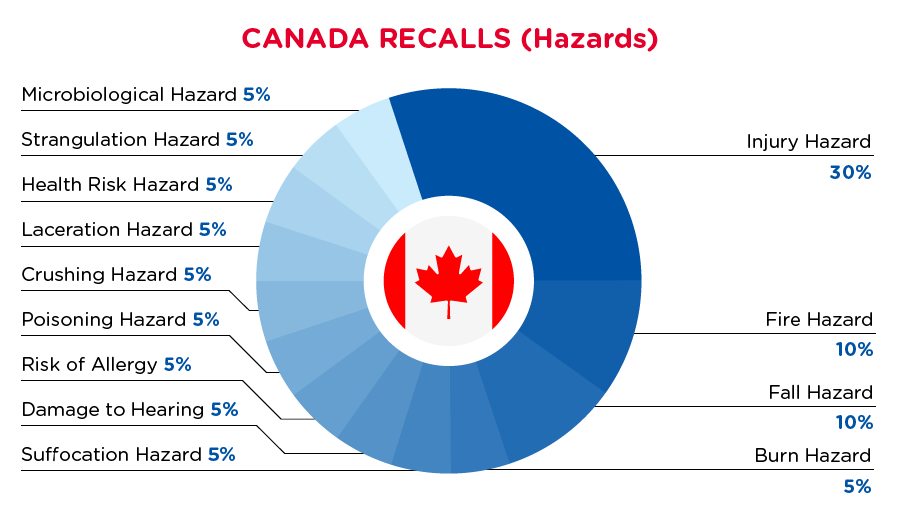
| Hazards | Frequency |
| Suffocation Hazard | 1 |
| Damage to Hearing | 1 |
| Fall Hazard | 2 |
| Injury Hazard | 6 |
| Risk of Allergy | 1 |
| Health Risk Hazard | 1 |
| Fire Hazard | 2 |
| Burn Hazard | 1 |
| Strangulation Hazard | 1 |
| Laceration Hazard | 1 |
| Poisoning Hazard | 1 |
| Crushing Hazard | 1 |
| Microbiological Hazard | 1 |
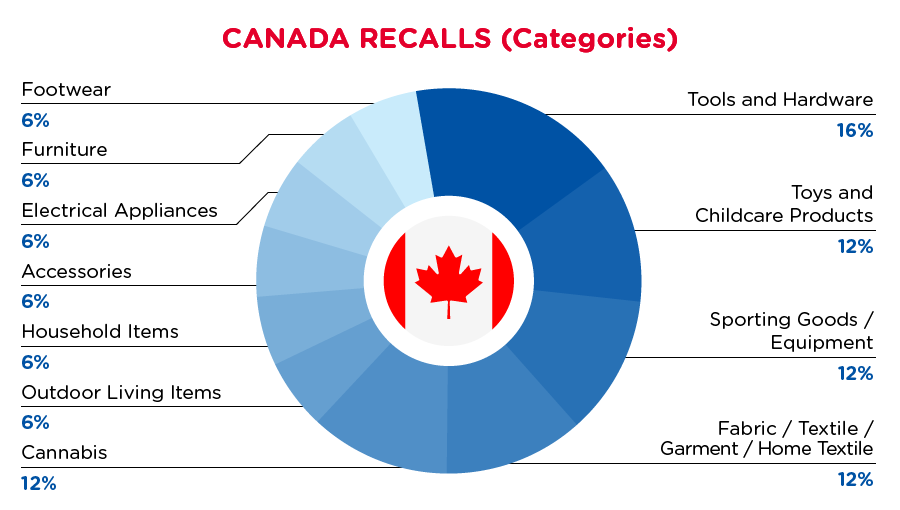
| Product Categories | Frequency |
| Outdoor Living Items | 1 |
| Toys and Childcare Products | 2 |
| Sporting Goods / Equipment | 2 |
| Household Items | 1 |
| Cannabis | 2 |
| Tools and Hardware | 3 |
| Fabric / Textile / Garment / Home Textile | 2 |
| Accessories | 1 |
| Electrical Appliances | 1 |
| Furniture | 1 |
| Footwear | 1 |
For a complete list click here
On 20 September 2021, Colombia Issued a Resolution for Food Contact Glass and Ceramics.
View Story Read MoreOn 20 September 2021, Colombia Ministry of Health and Social Protection published Resolution No. 1440/2021 to establish a technical regulation for food contact glass, ceramic and glass-ceramic.
The new regulation mainly includes:
- Application scope: tableware, ceramic cookware and articles of glass, ceramic or glass‑ceramic that are intended to come into contact with food
- List of HS codes for products within the regulation scope
- Exceptions and exclusions
- Permissible release limits and test methods for lead and cadmium
- Labelling requirement
- Sampling requirement
- Testing laboratories accreditation requirement
- Product certificate of conformity (CoC) requirement
The new regulation will enter into force on 20 March 2022.
Contact: Andy Choi (Senior Manager)
Phone: (852) 3185 8045
Email: regulatoryupdates@qima.com
On 15 October 2021, France published the Decree Order of 24 September 2021 relating to the maximum plastic content authorized in single-use plastic cups.
View Story Read MoreOn 15 October 2021, France Ministries of Ecology and Economy published the Order of 24 September 2021 relating to the maximum plastic content authorized in single-use plastic cups. The order establishes the timeline for the stepwise reduction of plastic content in single-use plastic cups.
The maximum plastic content in single-use plastic cups shall be:
- 15% as of 1 January 2022
- 8% as of 1 January 2024
- achieve zero value as of 1 January 2026; an evaluation will be performed during 2024 addressing the feasibility of this target
The order will enter into force on 16 October 2021.
Contact: Andy Choi (Senior Manager)
Phone: (852) 3185 8045
Email: regulatoryupdates@qima.com
On 29 June 2021, the French government updated Decree 2021-835 to introduce new Packaging Signage Requirements that will be effective on 1 January 2022.
View Story Read MoreThe decree defines the conditions for the application of the legislative provisions of the Environmental Code to ensure that any product placed on the market for households and subject to the principle of extended producer responsibility, excluding household packaging of glass beverages, is the subject of signage. This signage informs the consumer that this product is the subject of a sorting rule and contains information specifying the methods of sorting or bringing the waste from the product.
Based on this new requirement, France also published a new guideline on how the Triman Logo needs to be printed on packaging in France beginning January 2022. This is to ensure that a common format is used for the symbol and sorting device. A transition period is in place until 9 March 2023. Afterwards, packaging that is not compliant with the new Triman signage rules may no longer be placed on the French market.
Triman Logo Transition Period Milestones:
| Date | Events |
| 9 Sep 2021 | Validation by public authorities |
| 1 Jan 2022 | Entry into force of signage obligations |
| 9 Sep 2022 | End of Transition period to get packaging compliant |
| 9 Mar 2023 | All packaging in France must bear the new signage |
Contact: Vivian Chan (Technical Consultant)
Phone: (852) 3185 8052
Email: regulatoryupdates@qima.com
In Europe, when hazards are identified in Non-food Consumer Products, the Products will be recalled and published in the Safety Gate system, which is updated weekly. The European recalls from 01 October 2021 to 31 October 2021 are summarized below:
View Story Read More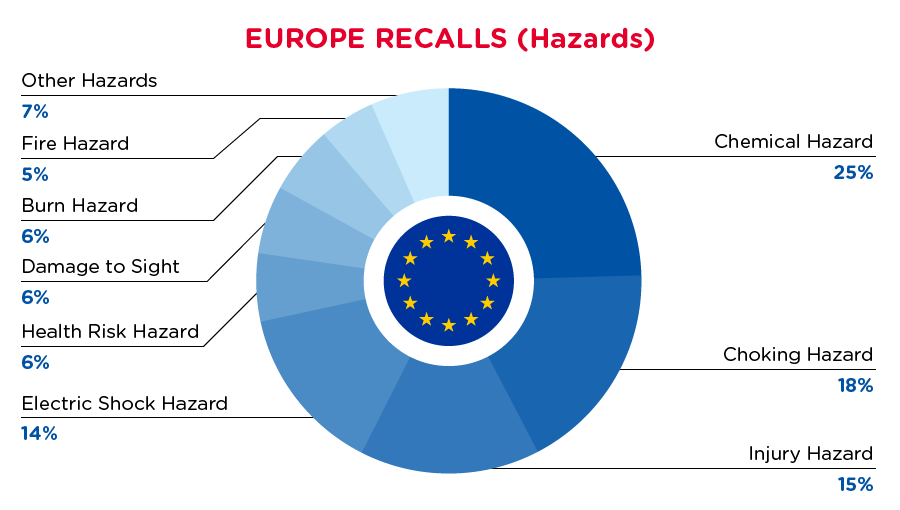
| Hazards | Frequency |
| Health Risk Hazard | 6 |
| Chemical Hazard | 26 |
| Electric Shock Hazard | 15 |
| Burn Hazard | 6 |
| Fire Hazard | 5 |
| Choking Hazard | 19 |
| Injury Hazard | 16 |
| Damage to Sight | 6 |
| Other Hazards* | 7 |
*Other Hazards include Suffocation Hazard, Damage to Hearing, Cut Hazard and Environmental Hazard with a frequency of less than 4.
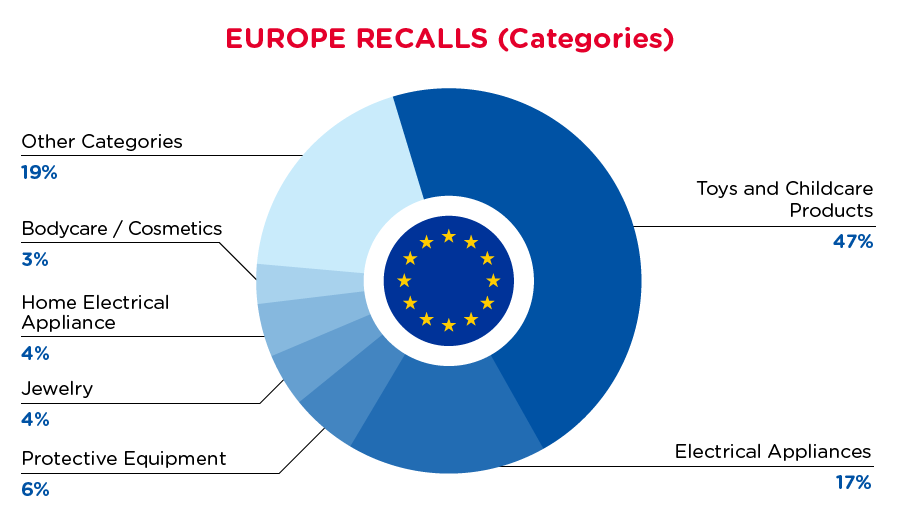
| Product Categories | Frequency |
| Bodycare / Cosmetics | 3 |
| Jewelry | 4 |
| Electrical Appliances | 15 |
| Protective Equipment | 5 |
| Toys and Childcare Products | 42 |
| Home Electrical Appliances | 4 |
| Other Categories* | 17 |
*Other Categories include Stationery, Furniture, Accessories, Footwear, Fabric / Textile / Garment / Home Textile, Sporting Goods / Equipment, Chemicals, Machinery, Computer / Audio / Video / Other Electronics & Accessories, Household Items, Outdoor Living Items and Tools and Hardware with a frequency of less than 3.
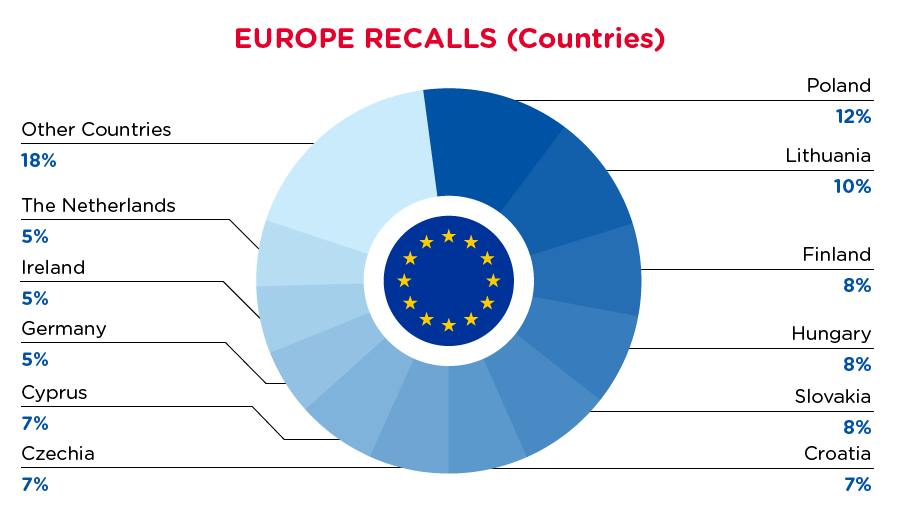
| Notifying Country | Frequency |
| Germany | 5 |
| Finland | 7 |
| Lithuania | 9 |
| Hungary | 7 |
| Croatia | 6 |
| Poland | 11 |
| Czechia | 6 |
| Ireland | 5 |
| Slovakia | 7 |
| The Netherlands | 5 |
| Cyprus | 6 |
| Other Countries* | 16 |
*Other Countries include Austria, Estonia, Belgium, Slovenia, Denmark, Romania, Spain, Sweden, Luxembourg and France with a frequency of less than 4.
For a complete list click here
In Australia, when hazards are identified in consumer products, they will be recalled and published in the Recalls and Safety Alerts Database on the Australian Competition & Consumer Commission website, which is updated daily. The Australia recalls from 01 October 2021 to 31 October 2021 are summarized below:
View Story Read More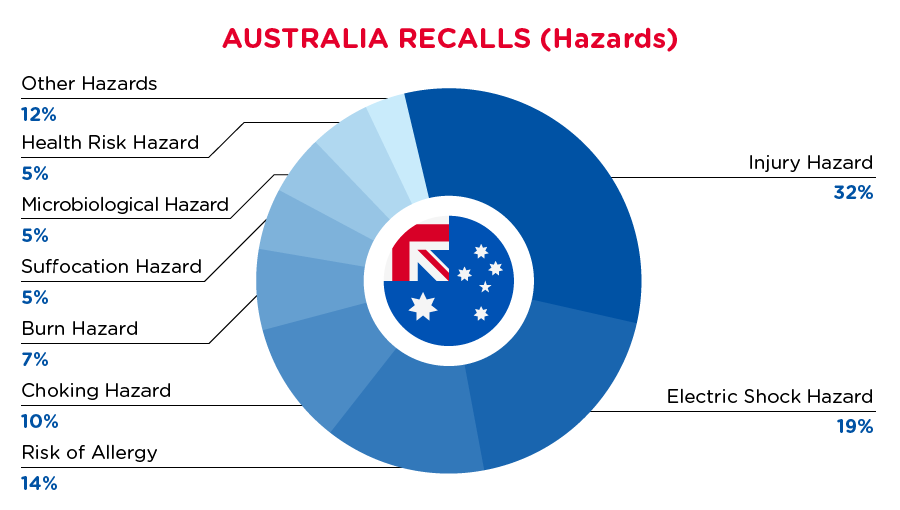
| Hazards | Frequency |
| Burn Hazard | 4 |
| Choking Hazard | 6 |
| Risk of Allergy | 8 |
| Electric Shock Hazard | 11 |
| Injury Hazard | 19 |
| Suffocation Hazard | 3 |
| Microbiological Hazard | 3 |
| Health Risk Hazard | 3 |
| Other Hazards* | 2 |
*Other Hazards include Fire Hazard and Drowning Hazard with a frequency of less than 2.
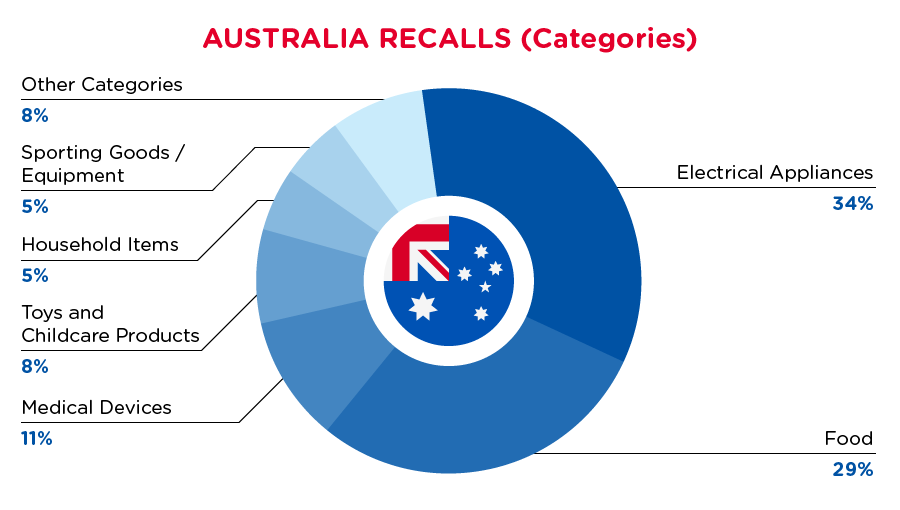
| Product Categories | Frequency |
| Electrical Appliances | 13 |
| Food | 11 |
| Household Items | 2 |
| Medical Devices | 4 |
| Toys and Childcare Products | 3 |
| Sporting Goods / Equipment | 2 |
| Other Categories* | 3 |
*Other Categories include Pharmacy, Tools and Hardware and Pet Items with a frequency of less than 2.
For a complete list click here
On 16 September 2021, The National Food Safety Standard GB 31604.8-2021 for Food Contact Materials and Articles – Determination of Overall Migration was published.
View Story Read MoreOn 16 September 2021, The National Food Safety Standard GB 31604.8-2021 for Food Contact Materials and Articles – Determination of Overall Migration was published by China's National Health Commission and China's State Administration for Market Regulation (SAMR). The new standard will replace the existing standard GB 31604.8-2016.
Comparing the new standard to the existing standard GB 31604.8-2016, GB 31604.8-2021,
- Revises the application scope - extends the application scope to overall migration in olive oil
- Revises the requirements for precision
- Adds ‘Part 2 Determine of overall migration in olive oil’
This standard will enter into force on 7 March 2022.
Contact: Andy Choi (Senior Manager)
Phone: (852) 3185 8045
Email: regulatoryupdates@qima.com
China standard GB/T 28011-2021 Shanks for Footwear was recently published. It applies to shanks of shoes (including boots) with a shoe size of 200 (mm) and above, but it is not applicable to wooden shanks. It will be effective 1 March 2022.
View Story Read MoreThis document replaces GB/T 28011-2011 "Shoes Steel Shaft".
Compared with GB/T 28011-2011, the main technical changes are as follows:
- Modified the file name;
- Modified "Scope";
- Added the definitions of "1 type shank", "L type shank" and "Y type shank";
- Modified product classification;
- Modified the requirements for "marks";
- Modified the requirements for "sensory quality";
- Modified the requirements for "longitudinal stiffness";
- Modified the requirements for "fatigue resistance";
- Modified the requirements for "hardness";
- Modified the requirements for "bending performance";
- Added icons for measuring the length of shanks, L type shanks and Y type shanks;
- Modified the "bending performance" test method.
Contact: David Zhao (Technical Consultant)
Phone: (571) 8999 7142
Email: regulatoryupdates@qima.com
On 6 September 2021, the Food Safety and Standards Authority of India (FSSAI) issued a Notification to amend Food Packaging Regulation, 2018.
View Story Read MoreOn 6 September 2021, FSSAI issued a Notification to amend Food Safety and Standards (Packaging) Regulations, 2018. According to the Notification, the amendment may be called the Food Safety and Standards (Packaging) Amendment Regulations, 2021 and the following restrictions will be added.
| Item | Specific Migration Limit (mg/kg) |
| Antimony | 0.04 |
| DEHP | 1.5 |
In addition, the public may provide comments to this Notification before 6 November 2021.
Contact: Andy Choi (Senior Manager)
Phone: (852) 3185 8045
Email: regulatoryupdates@qima.com
In China, when hazards are identified in consumer products, they will be recalled and published in the SAMR Defective Product Administrative Centre, which is updated daily. The China recalls from 01 October 2021 to 31 October 2021 are summarized below:
View Story Read More
| Hazards | Frequency |
| Cut Hazard | 3 |
| Safety Risk Hazard | 22 |
| Health Risk Hazard | 7 |
| Fall Hazard | 5 |
| Chemical Hazard | 5 |
| Electric Shock Hazard | 10 |
| Swallowing Risk | 3 |
| Fire Hazard | 4 |
| Suffocation Hazard | 5 |
| Other Hazards* | 10 |
*Other Hazards include Skin Irritation Risk, Crash Hazard, Choking Hazard, Entanglement Hazard, Damage to Skin, Injury Hazard and Burn Hazard with a frequency of less than 3.
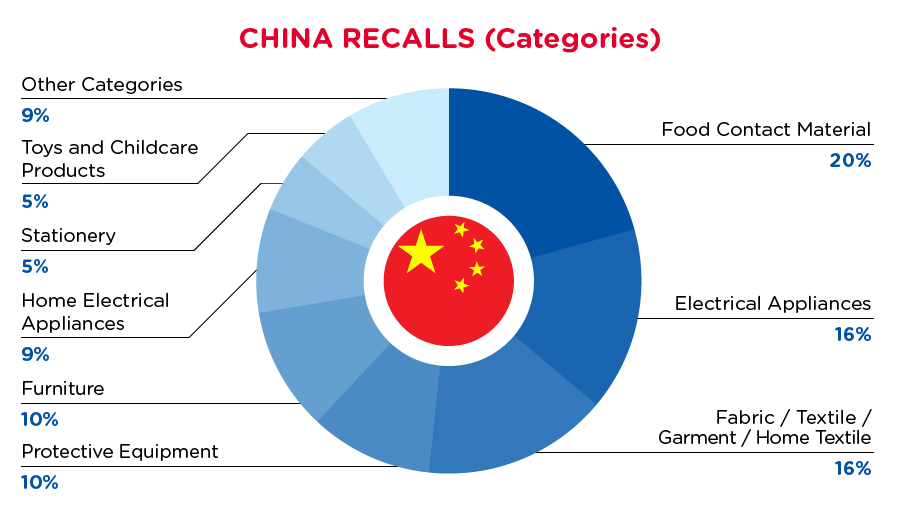
| Product Categories | Frequency |
| Stationery | 3 |
| Protective Equipment | 6 |
| Furniture | 6 |
| Fabric / Textile / Garment / Home Textile | 9 |
| Food Contact Material | 12 |
| Electrical Appliances | 9 |
| Home Electrical Appliances | 5 |
| Toys and Childcare Products | 3 |
| Other Categories* | 5 |
*Other Categories include Sporting Goods / Equipment, Footwear, Household Items and Tools and Hardware with a frequency of less than 3.
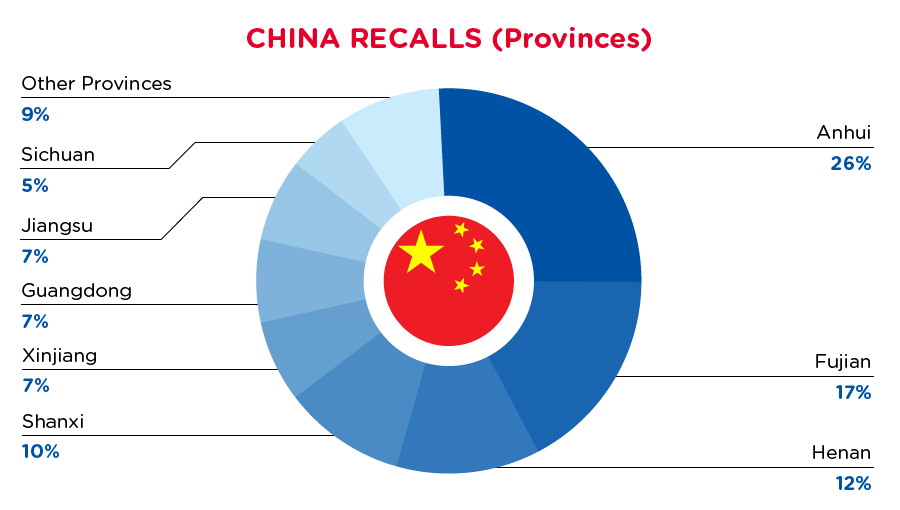
| Provinces | Frequency |
| Anhui | 15 |
| Xinjiang | 4 |
| Henan | 7 |
| Shanxi | 6 |
| Guangdong | 4 |
| Jiangsu | 4 |
| Fujian | 10 |
| Sichuan | 3 |
| Other Provinces* | 5 |
*Other Provinces include Yunnan, Jilin, Beijing and Shanghai with a frequency of less than 3.
For a complete list click here

